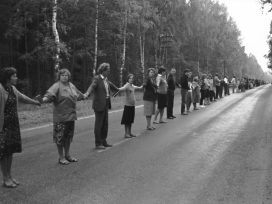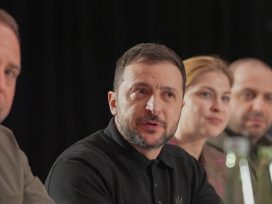Monuments in times of war
Since February 2022, Ukraine’s monumentscape has become contested symbolic ground: Russian aggressors alter, destroy or steal in demonstration of self-declared cultural superiority; Ukrainian iconoclasm is also on the rise. But might multiple local cultural meanings be lost in the process?
Across the world, monuments are being questioned. Statues of ‘great men’ have been wrested from the invisibility that Austrian writer Robert Musil identified as their most striking feature. Once revered, heroes and benefactors represented in stone and bronze are now being interrogated for being implicated in colonialism, slavery and antisemitism. Countless examples can be found in the English-speaking world, but even countries in continental Western Europe such as the Netherlands and Germany have started grappling with monuments as reminders of their colonial tyranny.
In Austria, no monument has inflamed passions more than that of Vienna’s antisemitic mayor Karl Lueger, installed in an eponymous square in the city he once governed. While calls to remove the statue and rename the square have so far gone unheeded, debate has generated a plethora of artistic ideas on how to estrange and contextualize this monument to a problematic politician. A temporary installation is currently on display in the square and there is a competition call for an artwork that would permanently reframe the monument.
Despite such deliberation, the West European and North American monumentscape is comparatively straightforward. Controversy typically focuses on individual statues visibly located in important public spaces. Most present-day visitors no longer feel any more than a tenuous connection with them at best, and in hindsight, the protagonists’ achievements often appear modest, especially when compared with being undeniably implicated in crimes.
Then there are the memorials to fallen soldiers of past wars, which despite a few prominent exceptions, are located at military cemeteries that rarely attract chance visitors. Or else they take the form of remembrance lists: in many countries, the names inscribed on monuments or church walls in most villages serve as not much more than relics of the past, even for locals, outside of special commemorative occasions. For non-residents, they usually carry no special significance – nor, by the same token, do they cause much offence.
War memorials in Russian-occupied Ukraine
Across the former Soviet Union, things are quite different. For decades, the Soviet leadership saw monument construction as a way of educating the populace. In post-Soviet countries, one encounters not only grand memorials but also serially manufactured statues or busts of state and party leaders, writers and artists at almost every turn. Yet such monumentscapes are more than mere propaganda props. In many parts of the former USSR, every town and village has memorials to some of the millions of soldiers, and sometimes to civilian victims, of the Second World War. A significant number were built on orders from above, but many were initiated by surviving veterans or family members. Over the second half of the twentieth century, all these memorials gradually turned into central venues of communal life. Often expanded to include additional monuments to later wars and catastrophes – Afghanistan, Chernobyl, Chechnya – they allow people to identify, in romanticized yet intense ways, with stories of suffering and resilience from the history of their hometowns and families.
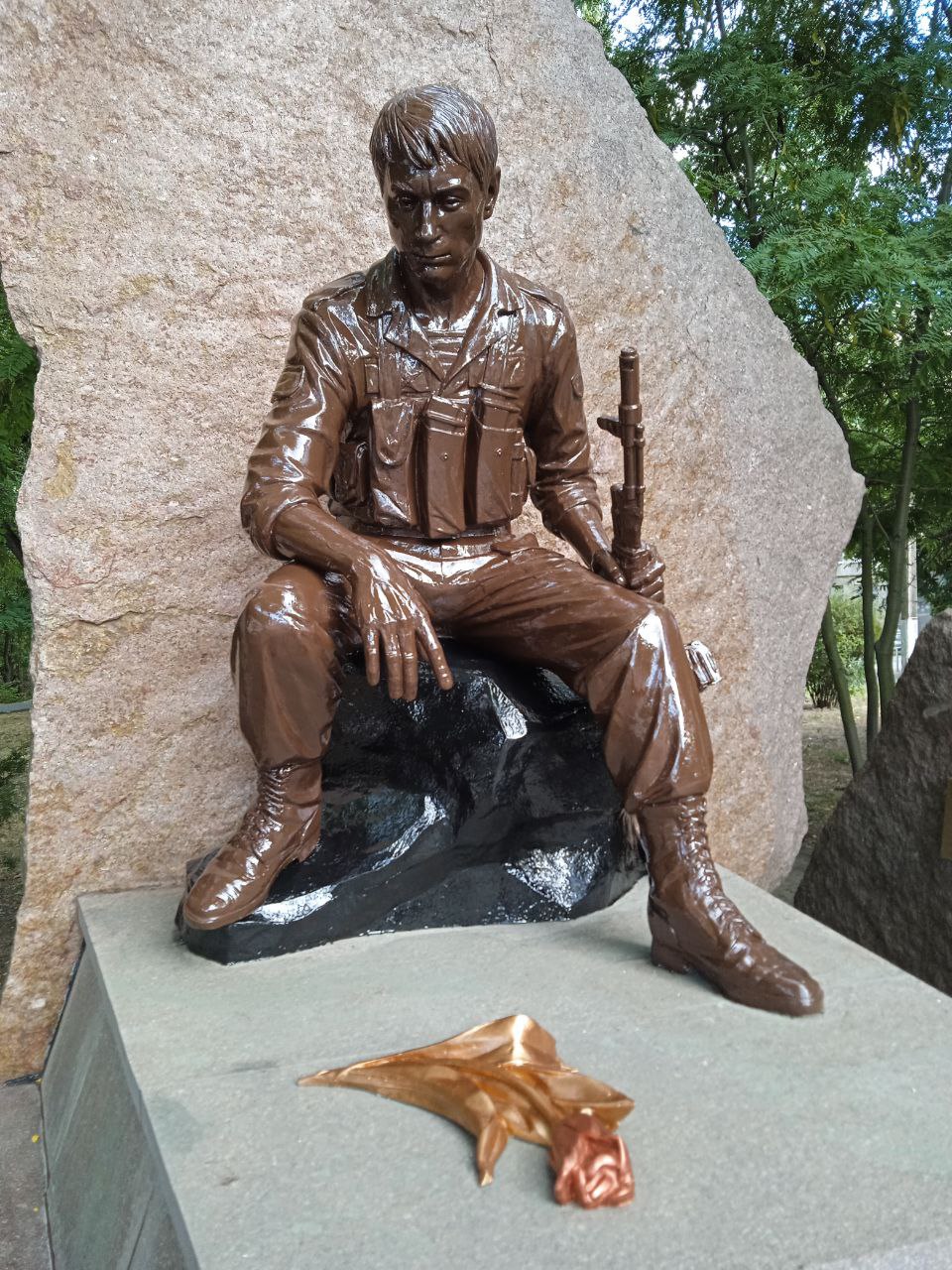
Occupied Kherson: memorial from 2013 to Soviet soldiers who died in Afghanistan. The polymer sculpture has been repainted in different colours. Photo: Mykola Homanyuk, summer 2022
Ukraine has a particularly rich and complex monumentscape. Completely occupied during the Second World War and the scene of some of its most gruesome acts of extermination, post-war Ukraine was the Soviet republic where the greatest number of memorials to the dead were built – a process that has never ceased, continuing even after the Soviet empire dissolved. In addition to memorials to the dead of past wars, countless monuments have been built to the fallen of the Anti-Terror Operation – the name Ukrainians give to military resistance against the Russian invasion, which started in 2014.
From then on, especially since the escalation of the war in February 2022, war memorials in Ukraine have been fiercely contested, over and over again. They are caught in the crossfire, as memorials were often erected in places of strategic importance, which saw heavy fighting during the German invasion and are again strategic today. Even more importantly, however, both sides see the ongoing conflict as a re-enactment of the Second World War – for Russia, it is a repeat war against supposed Nazis, whereas for Ukraine it is a patriotic war against foreign aggression, occupation and mass murder – giving monuments enormous symbolic significance.
Immediately after the full-scale invasion started, I contacted my Ukrainian colleague Mykola Homanyuk at Kherson State University. While organizing an academic airlift with Zoom lectures for university students and staff in the occupied city, we began exchanging observations on what was happening with war memorials in the Ukrainian regions newly occupied by Russia. We were struck by how important monuments, especially war memorials, were for the occupiers. On the one hand, they used them as backdrops for victory photos. On the other, their propaganda videos staged monument maintenance as proof that the memory of the glorious past was once again being honoured after years of supposed neglect.
We decided to systematically go through online propaganda channels and other media to find sources about these and other ways of dealing with monuments in every newly occupied district of Ukraine. We didn’t limit ourselves to online sources: Mykola remained in his hometown and courageously documented the fate of monuments, old and new, even as some Kherson residents were already being detained and ‘disappeared’ simply for suspicious content on their smartphones found during random checks.
In this way we gathered a wealth of sources that shed light on the different ways in which monuments are affected by war and occupation. The book we are currently writing analyses countless cases that point to the unabated significance that highly diverse monuments and memorials hold for both the occupiers and the resistance.
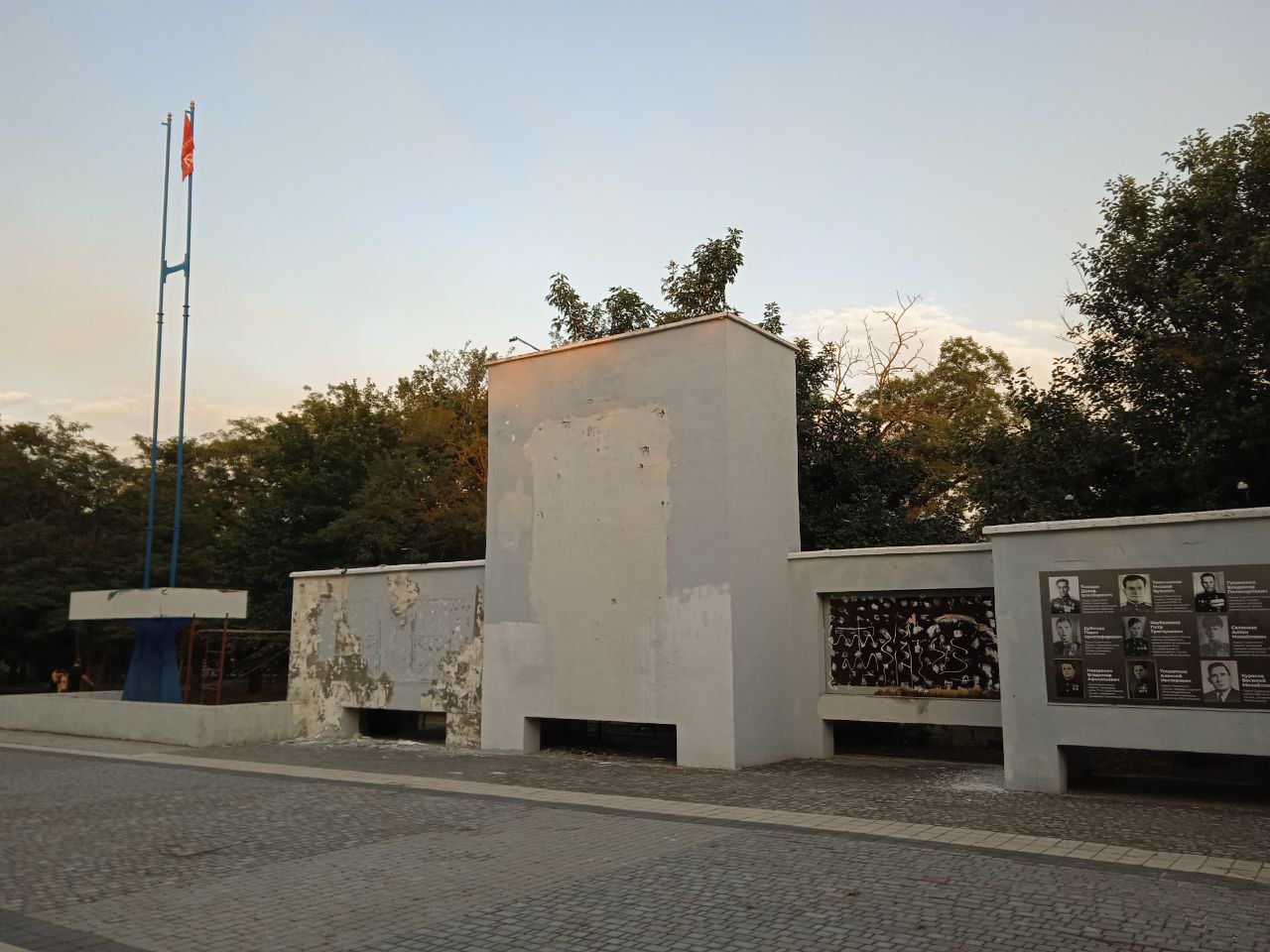
Occupied Kherson: the Ukrainian trident and portraits of those who lost their lives in Ukraine’s Anti-Terrorist Operation against the Russian invasion have been removed from a memorial and replaced with portraits of Second World War heroes. On the flagpole next to it, the Soviet Victory Banner has been raised instead of the Ukrainian flag. Photo: Mykola Homanyuk, summer 2022
Whereas some monuments – including Holocaust memorials in Kyiv and Kharkiv – were collateral damage, others were deliberately destroyed by Russian aggressors. They particularly singled out memorials and plaques honouring Ukrainians who had died defending their country since 2014, and those displaying national symbols such as the trident as reminders of past wars against Russia. The directors of public institutions, including schools, have often had memorial plaques covered in black foil as a precautionary measure to make them disappear from public view until liberation.
While memorials that openly commemorate Ukrainian resistance against Russia have clearly enraged the occupiers, others have evaded all-out destruction. Memorials to Ukrainian police officers killed in the line of duty, for example, were largely left untouched, even though some of the officers commemorated had died as volunteers in the fight against Russia. In Kherson, improvised memorials to members of Ukraine’s Territorial Defence Forces – the country’s military reserve – killed during the first days of the full-scale Russian invasion, also survived several months of occupation. Whereas most symbols of the Ukrainian army are anathema to the occupiers, in some cases they were seemingly willing to view members of ‘more civilian’ units as blameless victims of war. The Ukrainian police, who list fallen officers going back to the Soviet period, might even inspire something like a sense of corporate solidarity among the Russian National Guard units deployed to secure occupied territory behind the frontlines.
However, it would be wrong to imagine that the occupiers have pursued a coherent programme of iconoclasm or monument (re)construction. On the contrary, their approach to monuments has been situational and varied from one place to the next. The invaders have largely ignored certain villages located far from main roads and therefore strategically irrelevant, for example. In some villages, Ukrainian symbols remain on display in public space, although they are technically located on Russian-held territory. Conversely, while Second World War memorials are usually treated with reverence and spared from destruction, there are cases in which Russian troops appear to have deliberately damaged parts of such memorials simply due to their Ukrainian-language inscriptions.
Generally, however, the occupiers have tended to use monuments commemorating the ‘Great Patriotic War’ to justify their invasion. Russian propaganda texts and videos constantly repeat the claim that such monuments have been left to decay in the eight years since Euromaidan or even in the entire thirty years since Ukraine became independent. Russia has now ‘returned’, they declare, to restore historical justice and properly honour the memory of heroic ancestors who defeated the Germans. Soviet war memorials, however, have been no less well maintained in Ukraine than in Russia, and new ones have been added, for example when the newly discovered remains of Second World War soldiers are reburied.
Russian propaganda, therefore, resorts to unusual ways of making the myth of a special military operation for the purpose of monument preservation appear plausible. Proxy administrations have lit eternal flames at many war memorials, for example – including those where flames were never part of the original design. Paint interventions have also become a means of reappropriating war memorials. In the case of simple rural statues made of concrete or plaster, applying monochrome (often silver) paint is a long-standing tradition of weather protection, usually done in preparation for Victory Day or other commemorative celebrations. Since war memorials in Ukraine tend to be in good condition, the occupiers often choose particularly garish and varied colour schemes to leave no doubt as to the intensity of their dedication to renovating the memorials. They use different colours to highlight individual elements: black soldiers’ boots, gold medals, red stars. Even bronze statues aren’t exempt from this passion for multi-coloured decoration.
This use of paint is by no means a Russian innovation. In rural parts of southern Ukraine, local residents have been embellishing ‘their’ war memorials for years in a manner reminiscent of the polychromy of Greek and Roman statues. In Soviet times stricter rules governed people’s interaction with monuments, but the disappearance of the authoritarian system unleashed local creativity. In appropriating this practice and presenting it as a return of commemorative reverence following years of neglect, the Russian occupiers are following a time-honoured Soviet tradition. Ever since the end of the Second World War, the authorities have always been on the lookout for locally developed forms of commemoration. They have regularly co-opted those forms that appeal to the population and disseminated them more broadly with the help of the state apparatus, making sure to suppress any subversive potential such practices may have carried in the process.
The occupiers have used monuments to implement a policy of de-Ukrainianization and Russification. They have variously forced locals to participate in destroying Ukrainian monuments and taking care of Soviet memorials. The participation of prisoners of war in such actions is presented in Russian propaganda as a form of punishment or re-education.
Amid the ongoing war, Russian proxy administrations have taken the time to design, build and install a range of new monuments, some in place of destroyed monuments to Ukrainian soldiers. These fresh symbols of Russian rule range from small busts to lavish bronze statues. In the near totally destroyed city of Mariupol, a plastic statue of an elderly woman, who had greeted Russian troops near Kharkiv with a Soviet flag, and a grand equestrian monument to the medieval prince Alexander Nevsky have been erected. In several cases, Lenin statues, previously cleared from public space during Ukraine’s ‘Leninfall’, have been reinstalled – an irony of memory politics, as Vladimir Putin, in his pre-invasion speech, blamed Lenin for the existence of a Ukrainian state independent from Russia.
Finally, Russia’s claim to monuments in the occupied parts of Ukraine has also resulted in straightforward theft during the Russian retreat from some territories. A mere four weeks after Kherson was declared part of Russia in late September 2022, the withdrawing occupiers took monuments to Alexander Suvorov and Fyodor Ushakov – both eighteenth century Russian military leaders – with them, and removed the remains of Prince Grigory Potemkin from his grave. According to the occupiers’ skewed predatory logic, these objects were now part of Russia’s cultural heritage and had to be protected from Ukraine.
Ukraine’s new iconoclasm
These ruthless monument policies, and of course the invasion itself, has in turn triggered a new wave of iconoclasm in the unoccupied parts of Ukraine. Monuments to Soviet-era state and party leaders had already been removed from public space after the 2014 Revolution of Dignity. Since 24 February 2022, additional monuments from both the Tsarist and Soviet periods erected to cement the presence of Russia and its culture have been singled out for removal: monuments to Ukraine’s ‘reunification’ with Russia in the seventeenth century, statues of Alexander Pushkin, Maxim Gorky and other writers, whose widespread presence is now being read as a symbol of Russia’s self-declared cultural superiority. War memorials are no longer exempt from iconoclasm: monuments that glorify Soviet military rule rather than regular Red Army soldiers are common targets, but monuments to ‘liberator soldiers’ have also been removed in various places. In most cases democratically elected municipal councils have made these decisions, but there have also been cases of activists removing monuments on their own initiative, just as they had at the start of ‘Leninfall’– including monuments that honoured Soviet-era figures created in independent Ukraine such as a bust of Georgy Zhukov, the famous Second World War military leader. In October 2022, the city of Mykolaiv witnessed a clash between detractors and defenders of a monument to police officers killed in the line of duty. Those wishing to remove the monument perceived it as a symbol of the oppressive and unjust Soviet system. Those seeking to preserve the statue pointed out that while it had been erected in Soviet times, it had been funded by a grassroots campaign. Opponents of the monument eventually demolished it in the dead of night without waiting for an official decision.
When activists effect change with no prior deliberation, this raises the question of whether their iconoclasm has popular support – or whether it even requires such support to be legitimate. In November 2022, Mykola Homanyuk, together with colleagues, conducted a representative survey among remaining and displaced residents of Kharkiv about their attitudes towards street renaming and monument removal. The results were interesting in their complexity.
The majority supported the process involving as many residents as possible, but few are prepared to do more than vote in online polls. There is strong backing for ridding the map of Russian and Belarusian toponyms, Soviet ideological references and Russian/Soviet military leaders. However, more than half are in favour of keeping streets named after Russian/Soviet cultural figures or scientists, especially when asked about specific names (e.g., 79% wanted to keep the street name commemorating cosmonaut Yury Gagarin). Similarly, most approved of the removal of the monument to Marshall Zhukov but a plurality would have preferred to keep the one to Pushkin.
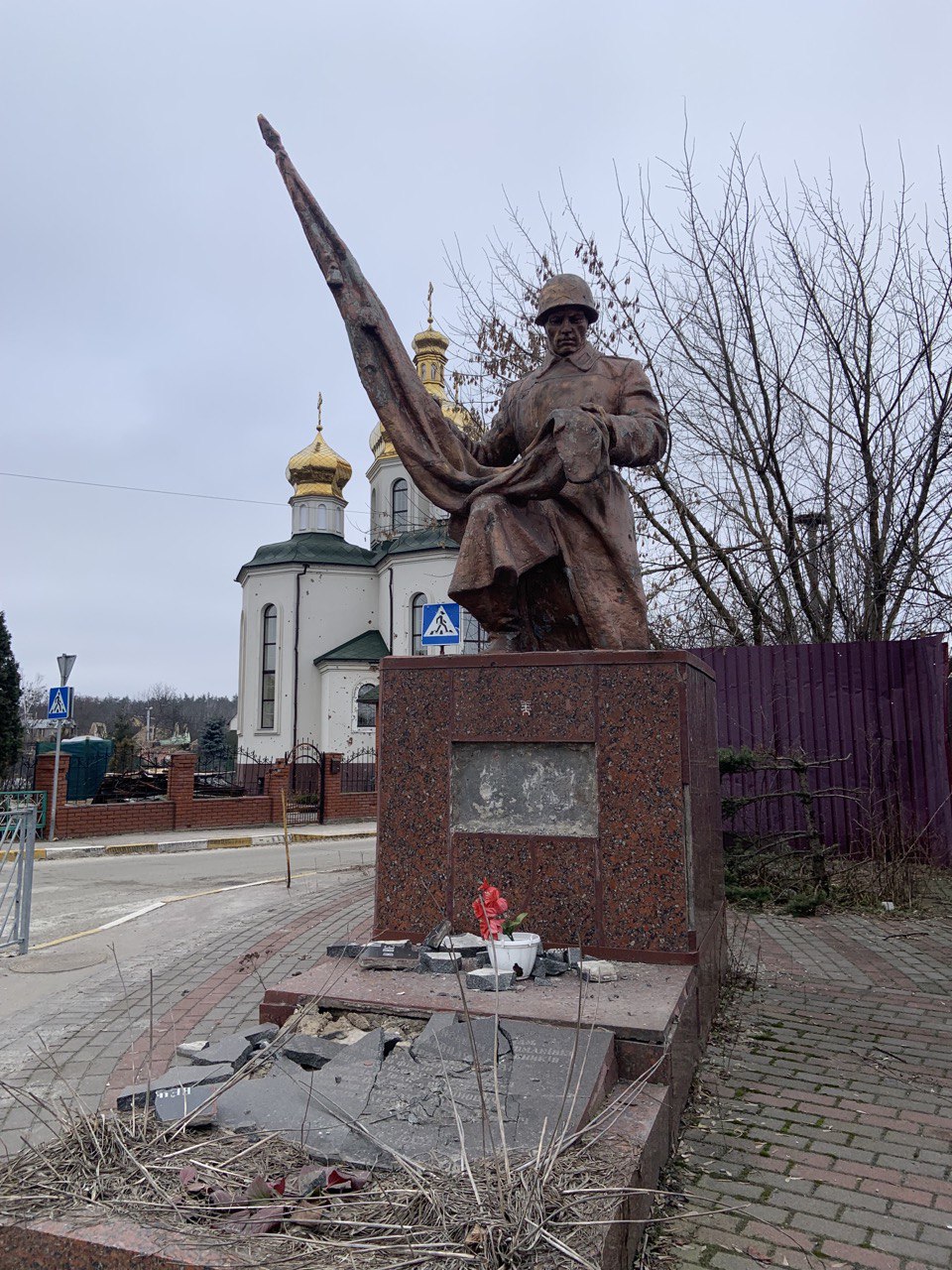
Memorial to Red Army soldiers near Irpin’. The statue has been left untouched, but the plaques with Soviet-era inscriptions have been smashed. Photo: Mykola Homanyuk, February 2023
Decentring perspectives on monuments
Russia’s brutal invasion is a direct attack not only on the people of Ukraine but also on their culture – on the cultural diversity, plurality and hybridity that makes the country so unique. The aggressor country is using both terror and the destruction of people, books and monuments to replace the intricacy and flexibility of everyday and commemorative culture in the occupied territories with a postmodern version of Russian/Soviet uniformity, and goading Ukraine to rid its landscape of symbols that could be perceived as Russian or Soviet.
How can we even discuss monuments under such conditions, especially those which, one way or another, evoke associations with the aggressor state, even if most of them were actually built by Ukrainians?
I would like to take up a suggestion that the Ukrainian artist, photographer and writer Yevgenia Belorusets made in a recent discussion about Soviet monuments in Ukraine. Since the beginning of the war in 2014, Belorusets has been tirelessly defending people from the Donbas who want to stay in their homes at any cost from being indiscriminately demonized as collaborators. Many of these people feel connected to their region’s industrial heritage from Soviet times, including their monument-strewn cityscapes. They see this heritage, and these monuments, as expressions of their own life-time achievements rather than mere symbols of Soviet injustice. To do justice to the ambiguity of monuments in such places – signs of oppression for some, elements of a familiar environment for others – Belorusets has proposed using the term ‘decentring’. Developed by the cognitive psychologist Jean Piaget, this concept denotes the capability, typically evolved in late childhood, to consider several dimensions of an object or several aspects of a situation at the same time.
As simple as this may sound, such a change of perspective could prove fruitful for discussions about monuments – especially, but not exclusively, in the post-Soviet region. Today, such discussions typically pit two rival camps against one another (leaving out the passive or indifferent majority). One side only sees the dark side of a monument, while the other sees only its sublime or familiar aspect. One side perceives any attempt to preserve a heroic figure from the Soviet pantheon as an expression of a colonial mindset and a pro-Russian stance. The other side experiences any call to topple or remove a monument as invalidating the achievements of their ancestors and their own sense of home.
The obvious fact that one and the same monument can mean more than one thing is mentioned surprisingly little in such discussions. This is especially evident in the case of monuments that commemorate the Second World War – be they statues of soldiers or tanks on pedestals. A monument that might fill one person with a sense of gratitude for liberation from National Socialist rule can appear threatening to another. It doesn’t even have to be about what the monument ostensibly commemorates. In present-day Ukraine, it is unlikely that anyone would want to erect a monument to the Bolshevik Fyodor Sergeyev (better known as Artyom) who died in 1921, a close friend of Stalin’s who used brutal force during the Civil War to quell peasants’ rebellions and national movements. Nevertheless, it is possible to appreciate the remarkable giant constructivist statue of Artyom, designed by the polymath artist Ivan Kavaleridze and installed in Sviatohirsk in 1927, as an expression of Ukrainian creativity.
Much more often than artistic aspects, however, what is at stake is everyday familiarity with monuments. When a statue disappears, one which residents had used as a meeting spot during summer nights, a backdrop to their first kiss, a half-noticed urban landmark, then it is as if they have lost a chunk of their biography. This plays an especially important role in former socialist countries, where parks and urban or even village squares were built even more frequently around central monuments than in most West European countries. It is one of the reasons why opponents of monument removal, in addition to old-age pensioners, historians of architecture or memory activists, often include members of youth subcultures: skaters, street artists or musicians who have come to appreciate a monument and its surroundings as their own little island amid a sea of public space. In times of war, as Yevgenia Belorusets says, dismantling familiar objects can have especially traumatic effects: in the face of everyday devastation, the deliberate destruction of yet another material object can feel like an attempt on a part of one’s own life. This is why, in the above-mentioned survey, the vast majority of those polled spoke out in favour of postponing iconoclasm and similar symbolic politics until after the end of the war.
Others – whose emotions are no less understandable – direct their wrath about the injustice they have suffered on statues in an act of Freudian affective displacement. Or else they argue that the very presence of Russian or Soviet monuments in Ukrainian public space will continue to offer its neighbour pretexts for aggression thinly veiled as a desire to protect the two countries’ common heritage. That is a valid point. Yet Russia’s regime has shown that statue removal can justify conquest and annihilation as much as monuments that remain. In fact, it is the continued presence of thousands of Soviet-era monuments in Ukraine that leaves the Russian regime at a loss for explanations and forces it to engage in propagandistic contortions.
The removal of some old monuments and the construction of new ones is probably inevitable in times of war and political upheaval – at least as long as we continue to believe that public monuments carry any meaning at all. In this process, feelings of anger and bitterness are as legitimate as are grief and the desire for a new beginning. However, it would be misguided to direct anger and the thirst for revenge against one’s fellow citizens, or worse to brand them as traitors for their attachment to monuments and what they stand for. Ultimately, it’s not about the monuments themselves but the kind of community that expresses itself through them.
This article has been published as part of the youth project Vom Wissen der Jungen, Wissenschaftskommunikation mit jungen Erwachsenen in Kriegszeiten, funded by the City of Vienna, Cultural Affairs. It was also supported by the FWF, grant M-3377.
Published 6 April 2023
Original in German
Translated by
Mischa Gabowitsch
First published by Eurozine (German and English versions)
Contributed by RECET © Mischa Gabowitsch / RECET / Eurozine
PDF/PRINTIn collaboration with
In focal points
Newsletter
Subscribe to know what’s worth thinking about.
Related Articles
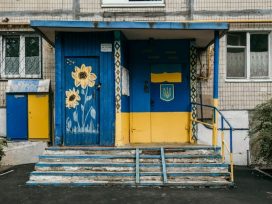
Ukraine faces its greatest diplomatic challenge yet, as the Trump administration succumbs to disinformation and blames them for the Russian aggression. How can they navigate the storm?

Mineral rush
Topical: Critical raw materials
Why does peace in Ukraine hang on a ‘mineral deal’ whose handling is more reminiscent of trade than negotiations? Perhaps because the global race for critical raw material mining is well and truly underway, digging for today’s equivalent of gold: raw earth elements and lithium critical for renewables and digital technology but also modern weaponry.




